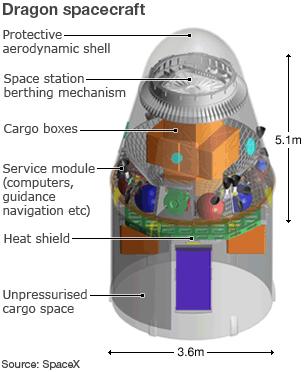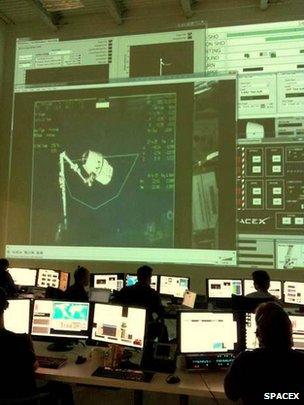Station grabs SpaceX Dragon ship
- Published
'Looks like we got us a dragon by the tail'
The California SpaceX company has seen its unmanned Dragon cargo ship attach successfully to the International Space Station (ISS).
Astronauts on board the platform used its robotic arm to grasp the vehicle and connect it to a berthing port.
Dragon is the first commercial vessel to visit the space station.
It is also the first American ship to go to the orbiting laboratory since the US space agency (Nasa) retired its shuttles last year.
US astronaut Don Petit was inside the ISS at the controls of the Canadarm2.
He reached out with the robotic appendage and grabbed the Dragon capsule at 13:56 GMT (14:56 BST).

"Houston, looks like we got us a Dragon by the tail," he radioed to Nasa mission control in Texas.
The capture was met by applause from controllers, at the Nasa centre and at the SpaceX HQ in Hawthorne, California, where Dragon's flight is also being overseen.
Just under two hours later, Petit used the arm to position the Dragon on the ISS's Harmony connecting node. A good seal was eventually confirmed at 16:02 GMT (17:02 BST).
There were moments during the day when the proximity sensors used by Dragon to find its way to the station did not work quite as expected, and SpaceX CEO and chief designer, Elon Musk, admitted after the berthing that his team had come close to commanding an abort.
But he praised the SpaceX and Nasa controllers for finding a work-around.
"It's just a fantastic day and a great day for the country and for the world," he said.
"This really is going to be recognised as significantly historical step forward in space travel."
Up until now, the vehicles flying to the space station have been government-owned and operated.
But the US space agency (Nasa) is looking to save money that it can then re-invest in some of its other programmes far beyond Earth, at asteroids and at Mars.
And it believes this can be achieved by contracting out the more routine tasks in low-Earth orbit to the private sector.
To that end, Nasa is providing seed funding of approximately $800m to SpaceX and another company, Orbital Sciences Corporation, to help them develop new rocket and cargo vehicles.
Orbital's rocket is called Antares, and its freighter is known as Cygnus. The pair should go into space together for the first time before the end of the year.

The SpaceX control room in Hawthorne, California, watches over the arm grab
Once these companies have proved the performance of their systems, they will start to receive lucrative ISS re-supply payments.
For SpaceX, its contract is valued at $1.6bn (£1bn) and calls for a minimum of 12 Dragon cargo missions to the ISS.
But freight is just the start. The ferrying of crews to and from the ISS will be the next service Nasa buys in.
SpaceX wants this business as well, and is developing the safety and life-support equipment that would allow Dragon to double up as an astronaut taxi.
The ISS crew will go inside Dragon on Saturday to unload its stores.
The astronauts will then pack the craft with 600kg of equipment and other items that need to be brought down to Earth.
Dragon is due to detach from the station next Thursday. It will re-enter the atmosphere and head for a splashdown via parachute in the Pacific Ocean off the coast of southern California.
What could be the first of the 12 contracted servicing missions is set for September.
Jonathan.Amos-INTERNET@bbc.co.uk and follow me on <link> <caption>Twitter</caption> <url href="https://twitter.com/#!/BBCAmos" platform="highweb"/> </link>
- Published22 May 2012
- Published19 May 2012
- Published18 May 2012
- Published10 May 2012
- Published16 April 2012
- Published10 April 2012
- Published20 March 2012
- Published5 April 2011
- Published8 December 2010